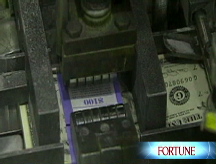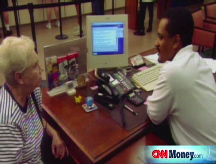Credit squeeze loosens
Both the overnight and 3-month rates continue to decline. Treasury prices fluctuate.
NEW YORK (CNNMoney.com) -- Bank-to-bank lending rates dipped again Friday, an indication that government moves to juice the economy with money supply was having an effect.
The overnight Libor rate fell to 1.67% from 1.94% Thursday, according to the British Banker's Association. The very short-term lending rate is at its lowest level since Sept. 20, 2004, when the rate was 1.66%, according BBA.
Libor is a daily average of what 16 different banks charge other banks to lend money in London and is used to calculate adjustable rate mortgages. The higher the rate, the tougher it could be for homeowners to pay those mortgages.
What a difference a week makes. Last Thursday, overnight Libor reached 5.09% and had spiked as high as 6.88% after the U.S. $700 billion bailout bill was signed into law on Oct. 3.
The U.S. government has worked with central banks around the globe to cut interest rates, increase currency exchange programs and backstop bank-to-bank lending in an effort to unclog the credit pipelines. The sharp drop in the overnight Libor rate is a sign that some confidence is returning, at least in the short term.
In fact, for the overnight bank lending rate is now just above the rate that the federal banks charge banks - a sign of normalcy returning to the credit markets, according to Steve Van Order, chief fixed income strategist at Calvert Funds. The federal funds rate is at 1.5% and as of Friday, the overnight lending rate now stands at 1.67%.
The overnight Libor rate has come down as central banks pump dollars into the system. "On the short term basis, there is confidence for banks to lend to each other," added Van Order.
Longer-term lending still tight: The 3-month Libor marched lower for the fifth day in a row, falling to 4.42% from 4.50% Thursday, according to Bloomberg.com, but they still remain at elevated levels.
Just last week, the 3-month Libor had surged to 4.82% - the highest since mid-December 2007. By comparison, it was only 2.82% a month ago.
"Things have improved from the doomsday scenario that we saw last week, but it is by no means suggesting that it is ok," said Michael Cheah, senior portfolio manager at AIG Sun America.
While banks had already tightened their lending amid the housing implosion last summer, the markets got really squeezed after Lehman Brothers collapsed last month. The fear was that if one major investment bank was having trouble, then so were others. Translation: banks were fearful of lending to institutions that might not be there tomorrow to repay the loan.
So, while the Libor rates continue to come down, it will still take some time before the credit squeeze is loosened.
"Until you start to see the 3-month Libor rate see a more pronounced move, I don't think we are out of the woods," said said Kenneth Naehu, managing director and head of fixed income at Bel Air Investment Advisors. "But we are seeing signs of improvement."
Longer term lending rates should fall further as central banks continue to get dollars pumped into the system on a longer-term basis, said Van Order. In addition, on Oct. 27, when the Fed begins actually purchasing commercial papers, providing short-term funds for businesses, that should also work to ease credit markets.
One analyst said that a key component to seeing the credit markets showing longer-term relief was for home prices to stop falling. "Falling home prices would continue to make the consumer unhappy and make the banks unwilling to lend money," said Cheah. Falling home prices make banks unwilling to lend money to consumers because the bank's collateral for the loan looses value.
But, with mortgage rates still elevated, that will take some time. The average 30-year fixed-rate mortgage was up at 6.46% from 5.94% the week earlier, according to a report issued by Freddie Mac (FRE, Fortune 500) on Thursday.
Market gauges: Two market indicators showed signs of improvement for the credit market.
The "TED spread" declined to 3.52% from 4.11% Thursday, signaling some modest optimism. The TED spread measures the difference between the 3-month Libor and the 3-month Treasury bill, and is a key indicator of risk. The higher the spread, the more unwilling investors are to take risks. The spread was 1.04% just a little over a month ago and reached a record high of 4.65% last Friday.
Another indicator, the Libor-OIS spread, also edged lower to 3.28% from 3.39% Thursday. The Libor-OIS spread measures how much cash is available for lending between banks, and is used for determining lending rates. The bigger the spread, the less cash is available for lending.
Treasurys: Government bond prices fluctuated Friday, reflecting the same market uncertainty and volatility that has been seen in the equity markets recently.
The Dow Jones industrial average briefly turned positive and was down only 30 points after tumbling more than 250 points earlier Friday. The Dow had a similar ride on Thursday, surging some 401 points, after having fallen as much as 380 points in the late morning.
Treasury prices are reacting partly to investor anxiety and partly to an influx of supply as the Treasury Department seeks to fund its various bailout initiatives.
On Friday, the Treasury offered $30 billion worth of 74-day bills and another $30 billion worth of 94-day bills. The $60 billion worth of notes the government planned to auction Friday are part of the Supplementary Financing Program that the government announced Sept. 17 to "provide cash for use in the Federal Reserve initiatives," according to a statement on the Treasury Web site.
The $60 billion worth of notes auctioned Friday follows $70 billion worth of cash management bills that were auctioned Thursday.
"Typically, when you have a lot of supply in the short term, the market would sell off," added Cheah. The result of the two sentiments are keeping prices gyrating Friday.
The benchmark 10-year note was up 10/32 to 100-18/32 and its yield fell to 3.92% from 3.96% late Thursday. Bond prices and yields move in opposite directions.
The 30-year bond fell 1 to 103-1/32, and the yield rallied to 4.31% from 4.25% Thursday.
The 2-year note held steady at 100-23/32 and its yield remained at 1.61%.
The yield on the 3-month bill rallied to 0.80%, up from 0.39% Thursday, as the price fell. The yield on the 3-month Treasury bill is closely watched as an immediate reading on investor confidence. Investors and money-market funds shuffle funds into and out of the 3-month bill frequently, as they assess risk in the rest of the marketplace. A higher yield indicates that investors are slightly more optimistic.
The late-day jump in the yield on the 3-month yield was another sign of confidence for the credit markets. "Everything that has been rolled out seems to have people feel a little bit better," said Van Order. ![]()






